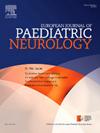155例儿童发育性和癫痫性脑病的综合遗传学诊断和治疗展望
IF 2.3
3区 医学
Q3 CLINICAL NEUROLOGY
引用次数: 0
摘要
我们研究了一组患有发展性和癫痫性脑病(DEE)的儿童,这是一组以早发性癫痫和严重发育迟缓为特征的神经系统疾病。在经过盲法交叉验证过程后,根据临床标准从三所大学医院招募病例,大多数病例均接受阵列cgh和基于外显子组的基因面板分析。共纳入155名受试者。105例(68%)确诊为基因诊断。大多数患者(71%)在一岁前出现症状。在这一年龄组中,73%的儿童发现了致病变异,这是迄今为止报告的病例比例最高的。遗传异质性高,涉及40个不同基因。最普遍的基因是SCN1A。在多个患者中发现了8个基因,占所有诊断的50%。剩下的基因代表了极其罕见的疾病。在许多情况下,分子诊断导致治疗适应,并允许遗传咨询。这些结果强调了基因调查的重要性,特别是在1岁之前出现症状的儿童中。最后,我们在意向治疗方法中评估了致病变异,发现几乎一半的变异理论上适用于使用反义寡核苷酸(ASOs)进行个性化治疗。本文章由计算机程序翻译,如有差异,请以英文原文为准。
Comprehensive genetic diagnosis and therapeutic perspectives in 155 children with developmental and epileptic encephalopathy
We studied a retrospective cohort of children with developmental and epileptic encephalopathy (DEE), a group of neurological conditions characterized by early onset epilepsy and severe developmental delay. Cases were recruited from three university hospitals based on clinical criteria, after a blinded cross-validation process, and most were subject to both array-CGH and exome-based gene panel analyses. 155 subjects were included. A genetic diagnosis was identified in 105 (68 %). A majority of patients (71 %) had onset of symptoms before the age of one year. In this age group a disease-causing variant was identified in 73 % of children, the highest proportion of cases reported so far. Genetic heterogeneity was high, involving 40 different genes. The most prevalent gene was SCN1A. Eight genes were identified in multiple patients and accounted for 50 % of all diagnoses. The remaining genes represented ultra-rare disorders. In many cases, molecular diagnosis leads to treatment adaptation and allows for genetic counseling. Those results highlight the growing importance of genetic investigations especially in children with symptoms onset before the age of 1. Finally, we evaluated the disease-causing variants in an intention-to-treat approach and found that almost half would theoretically be amenable to personalized therapy using antisense oligonucleotides (ASOs).
求助全文
通过发布文献求助,成功后即可免费获取论文全文。
去求助
来源期刊
CiteScore
6.30
自引率
3.20%
发文量
115
审稿时长
81 days
期刊介绍:
The European Journal of Paediatric Neurology is the Official Journal of the European Paediatric Neurology Society, successor to the long-established European Federation of Child Neurology Societies.
Under the guidance of a prestigious International editorial board, this multi-disciplinary journal publishes exciting clinical and experimental research in this rapidly expanding field. High quality papers written by leading experts encompass all the major diseases including epilepsy, movement disorders, neuromuscular disorders, neurodegenerative disorders and intellectual disability.
Other exciting highlights include articles on brain imaging and neonatal neurology, and the publication of regularly updated tables relating to the main groups of disorders.

 求助内容:
求助内容: 应助结果提醒方式:
应助结果提醒方式:


